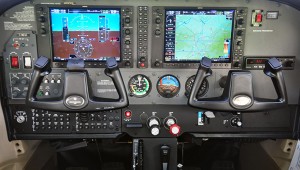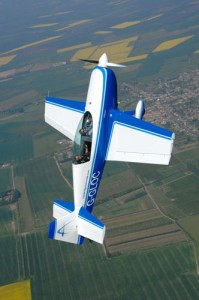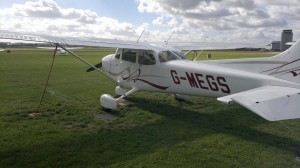Having had a glance through the training sheet, I was semi-prepared for the tick box objectives of this lesson before arrival (though I have to admit I’ve not yet memorised the emergency procedures sheet quite as well as I should – equally I was expecting a slight grilling on this).
Briefing
With several of the clubs airplanes in for maintenance, it would be another trip in G-MEGS. I couldn’t have timed finishing circuits and having a flight in the book for MEGS any better, now it’s playing to my advantage, as not all students are allowed to fly G-MEGS (I certainly went a year walking past it). If I heard the instructor right, you need at least two solo’s – these are just club rules, but I’d guess the lack of analog gauge planes is causing other students some availability issues.
Found myself quite looking forward to another go in the glass cockpit aircraft.
The objective was to tick off a number of training boxes:
- Short-field take off
- Revision of slow flight
- Revision of Climbing/Descending (with an emphasis on doing it at set speeds / rates).
- Stalling with Flaps
- Rejoining the circuit
Take Off
I’m quickly getting the impression that G-MEGS lives its life in tip top form, perhaps not getting the same abuse of trainee pilots like the other Cessna’s.
All pre-checks done, the plan had been to ask Air Traffic for permission to back track on the runway (taxi the wrong way up the runway in order to maximise distance for take off), with a plane coming into land and a mile long runway if we didn’t we might have got an immediate clearance. I figured it’d still be more fun to do a back track and take off from there, so I requested permission to do it…. ATC as expected came back with instructions to hold…….once the Piper was down they were obliging to the request.
Lined up, with a full mile of runway ahead of us: 10 degrees of flaps set, toe brakes firmly held down, the engine was run up to 2,000RPM. With the engine roaring, the brakes were released and the rest of the throttle opened……Everything that could be done to get this plane in the air in the shortest possible distance (apart from asking the instructor to get out), had been done and now we were charging down the runway and soon up, up and away. Hope the kids that were at the airport enjoyed seeing this particular plane take off.
Climb out
Aiming for best angle of climb, this was done initially at 62 knots, before switching up to 80 knots once we were at a good altitude. Really just to get some practice in flying best angle of climb. Found the digital tape a bit easier to work with on this second trip.
Kept the climb coming up before starting a turn out to the right at 2,000ft.
Given the rubbish weather that had been forecast in the days prior, it was actually really nice flying. A few clouds, but mostly blue sky and stable air.
Straight, Level……and Slow
My instructor asked me to fly at 70 knots.
I could just about remember that I wanted somewhere around 1,700 RPM to get this and it actually came together and trimmed up really nice. 2,500ft @ 70 knots. Nice enough.
We did a bit of work with the flaps and various other speeds and familiarisation of flying out of the circuit.
Air Traffic Control were starting to get slammed by aircraft wanting to join or leave and we had a handful of planes to keep a look out for. The Extra 200 was up (very fast, very aerobatic!), a Tiger Moth was around (very slow) and a Piper was somewhere in the area, so lots to be looking out for!
Orbits at set speed
Just after being asked to make a turn, at 11 O’clock I spotted a planes wings 90 degrees dead flat to us, it was the Extra, doing a stall turn. I must confess to now largely stopping and watching it complete the maneuver, they look good from the ground, when you’re altitude level with them, it looks even better……I have a flight in the Extra 200 booked for a couple of weeks time, started to really look forward to getting back up in that plane, sooo much fun!
My orbits were ok, I think the Extra distracted me a little, the first I lost ~130ft and that loss of height threw the speed from 70 to 82knots. All generally ok, but I can normally orbit plus/minus 20ft.
Climb to 4,000ft
As we were about to revisit stalling with the flaps down and stalls with flaps & power (approach configuration) it was time to climb back up, avoiding the clouds, to 4,000ft. It’s been a while since I’ve been up this high 🙂
Found myself getting quite used to G-MEGS and the glass cockpit, once you get over the newness of it all it’s really quite easy to work with.
After an orbit to check the area for other aircraft, we did a stall with 20 degrees of flaps, with the nose and left wing dropping, it’s a fairly simple matter of pushing the control column forward, applying full power, adding some rudder and leveling the wings before recovering into a climb.
After another stall, I was asked to do one with flaps and power. It all went fine, except I must have missed the request to recover on the ‘first sign’ (buffeting / stall warner), as I was on my way to letting it stall before the instructor said “Any signs of a stall?” ……of course, oh right you want me to recover it already. Fair enough.
Just to make sure, we did it again.
Descending at a set rate of descent
What goes up……… in this case, must come down at a pre-determined rate of descent. Really just to polish up and check I could still do this stuff (it’s strange but I’ve been going round in circuits so much that it’s been months since I’ve had to descend for anything but approach to a runway).
First I was asked to descend at 500ft/min. Seemed to get it all trimmed out nice for that no real issues and the stable atmosphere was no doubt helping the performance. Next it was to try and make it 700ft/min. This time the rate was wondering +/-50ft or so, but generally seemed a decent descent.
We leveled out at 2,500ft.
Just time to practice a few of those emergency scenarios I’ve not memorised enough, I think I had them in my head on run up to first solo, but now they’re slipping away, so some homework required 🙂
Circuit Rejoin
This would be my only “arrrh” moment of the flight, we got the ATIS information easy enough and my call to Approach was ok, they said to contact Tower and this was all good. I then pressed the mic button to call the Tower and it should have gone like this:
“Cambridge Tower, Golf Mike Echo Golf Sierra, with information Alpha, QNH 999 hectopascals, request standard overhead join.”
Should have……but instead went like this:
“Cambridge Tower, Golf Mike Echo Golf Sierra, with information Alpha……….”
At which point my brain blanked out and my instructor took over to rescue the call. I think the only issue here is I’ve not spent enough time familirising myself with the chain of events and when/who I’ll be talking to next, so I was trying to remember the who and the sequence and the sequences that would follow.
That screw up out of the way, the rest of the calls for joining the circuit were good and I was quite happy talking to the tower as we were put into a holding pattern over the airport due to traffic.
Descending on the dead side of the runway, it still surprises me how low 1,000ft feels when you’ve had an hour at 4,000ft. Was a reasonable descent with an aircraft taking off as we were flying the crosswind leg of the circuit, just to keep things interesting.
Crosswind Landing
The weather was turning on us, from blue sky it was now an 8 knot crosswind, not far from the limits of a student. I’ve spent a lot of time thinking through my crosswind landings, where they weren’t brilliant and consciously thinking about being more responsive.
Final approach was flown with the nose facing ~30 degrees right of the runway.
Leaving it a touch late to kick it straight (we were maybe 20ft off the ground), touch down was feather like and landings like this really put the icing on the cake of any lesson.
It had taken a bit of runway to get it all straight and calm, so ATC cleared us to back track and exit at Charlie, we could have got off at Delta but it’s a long old grass taxi if you get off there, so always grateful for their support.
Debriefing
All in all a good and very enjoyable lesson, I know there were a few mostly minor bits I needed to tidy up, but I was happy with everything and the instructor seemed pretty happy, noting a decent landing in crosswind (he’s been in some of my more awful landings).
The weather is just about holding and/or I’m getting pretty lucky, it won’t last I’m sure 🙂


